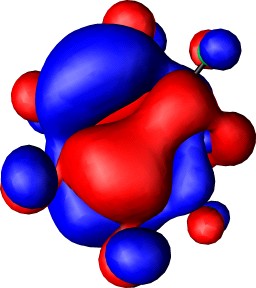
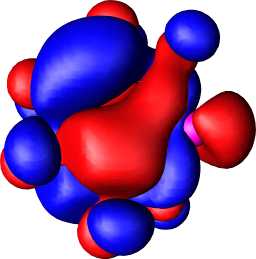
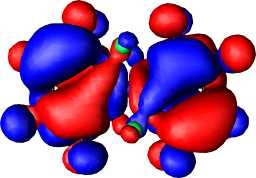
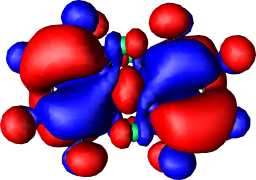
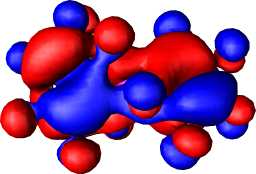
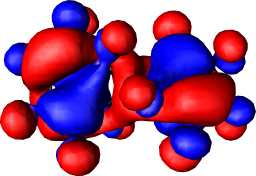
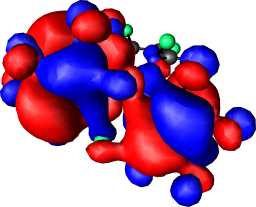
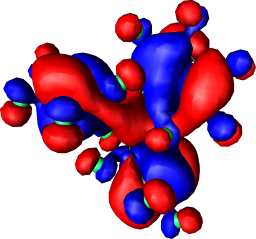
Summary: We propose that a general class of bis and tris-spiro 7-membered ring systems with a common atom X, of which there are a number of examples characterised crystallographically, can in fact be considered as spiroaromatic molecules in which each ring exhibits some degree of Möbius 4np-electron aromaticity. The aromaticity is probed as a function of the spiro-atom using ab initio calculations of the NICS(0) values, which indicate that the Möbius-aromaticity increases as the spiro-atom is changed e.g. from Al to P, and from e.g. P to As.
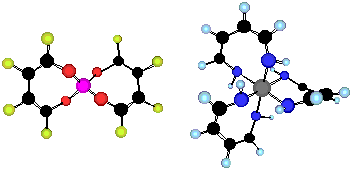
| yetreu/B(III)b | perjeb/Al(III)c | zohvib/Al(III)d | ubiqur/In(III)e |
|---|---|---|---|
| kezqah/Ga(III)f | gukdiz/Si(IV)g | gukdul/Ge(IV)g | gajfus/Sn(IV)h |
| mspaps/P(V)i | paqwuz/P(V)j | eapdop10/P(V)k | doxlor/As(V)l |
| hegday/Sb(V)m | yegduj/Bi(III)n | tpcate/Te(IV)o | tectcl/Te(IV)p |
| qirpuc/La(III)q | qazreo/Y(III)r | govsoz/Ti(IV)s | cigtuh/Ti(IV)t |
| bzdtzr10/Zr(IV)u | HOVTUH/V(IV)v | rilhoj/Nb(V)w | bzdtnb10/Nb(V)x |
| cuqgea/Cr(III)y | doxqai/Cr(V)z | sixwif/Mo(V)z | gefkor/W(IV)aa |
| Table 2. B3LYP/6-31G(d) Calculated energies (Hartree) and NICSa Values (ppm) for 1-5 | |||||
|---|---|---|---|---|---|
| Substituentsb | Energy, Y=O | NICS (angle)a | Energy, Y=NR | NICS (angle)a | |
| 1, X=N, R=H | -359.53314 | 17.4 (45.7) | -319.93038 |
26.7 (34.9) | |
| 1, X=N, R=F | -756.39305 (365.7i)c | 11.1 (54.0) | -915.07525
(189.9i)c |
-1.0 (59.0) | |
| 1, X=P, R=H | -646.31012 | 18.6 (23.7) | -606.60521 |
19.4 (38.0) | |
| 1, X=P, R=F | -1043.17777 (167.6i)c | 14.3 (41.2) | -1201.76006
(112.6i)c |
-2.0 (54.6) | |
| 2, RR, X=N, R=H | -664.72355 | -1.3 (76.6) | -585.371678 |
-2.8 (73.8) | |
| 2, RR, X=N, R=F | d | d | -1775.73438 |
-9.0 (84.3) | |
| 2, RR, X=P, R=H | -951.62957 | -0.2 (56.6) | -872.17703 |
-0.7 (55.4) | |
| 2, RS, X=P, R=H | 0.2e | -0.3 (57.4) | 4.8e |
-0.7 (54.2) | |
| 2, RR, X=P, R=F | -1745.37896 | -4.5 (63.2) | -2062.50669 |
-9.3 (64.7) | |
| 2, RS, X=P, R=F | 0.9e | -4.5 (62.9) | -0.6e |
-8.8 (60.0) | |
| 4, X=P, R=H | -796.78568 | -7.4 (0.0) | -717.36303 |
-9.8 (0.0) | |
| 3, RRS, X=Al, R=H | -1158.153405 | 0.2, 0.3 (33.5, 34.4) | -1038.79166 |
0.0, 0.1 (39.0, 39.1) | |
| 3, RRS, X=Si, R=H | -1205.36111 | -1.0, -0.4 (43.0, 53.0) | -1086.03770 |
-1.4, -1.6 (42.5, 42.3) | |
| 3, RRS, X=Ge, R=H | -2990.82401 | -2.5,-2.3 (57.7, 58.9) | -2871.52125 |
-2.2,-2.9 (44.5, 53.9) | |
| 3, RRS, X=P, R=H | -1257.16780 | -2.6, -2.7 (67.2, 66.9) | -1137.8865 |
-3.4,-3.4 (42.0, 53.9) | |
| 3, RRR, X=P, R=H | 1.7e | -2.2 (66.5) | -4.7e |
-4.2 (55.0) | |
| 3, RRS, X=P, R=F | -2447.98997 | -6.7, -6.9 (69.2, 69.0) | -2923.62738 |
-9.4, -10.0 (69.2, 69.0) | |
| 3, RRR, X=P, R=F | 0.8e | -6.6 (69.3) | 5.0e |
-10.2 (62.8) | |
| 3, RRS, X=As, R=H | -3149.58333 | -3.7,-3.4 (67.3, 68.3) | -3030.31362 |
-4.3, -4.4 (56.7, 58.8) | |
| 5, X=P, R=H | -1024.96531 | -6.3 (0.0) | -905.65126 |
-3.0 (0.0) | |
aNICS(0) value, ppm (dihedral angle a-b-c-d). b The designation RR/RS or RRR/RRS indicates relative rather than absolute chiral configurations for the 7-membered rings. c Wavenumber for imaginary normal mode corresponding to distortion to 6. d Dissociates to C4F4O2 and C4F4NO2+. e Energy (kcal/mol) relative to chiral diastereomer.
Figure 1. B3LYP/6-31G* computed molecular orbitals, contoured at 0.01 Hartree for (a) HOMO of 1, X=N, Y=NF, (b) HOMO of 1, X=P, Y=NF, (c) HOMO of 2, X=N, Y=NF, (d) HOMO-1 of 2, X=N, Y=NF, (e) HOMO of 2, X=P, Y=N, (f) HOMO-1 of 2, X=P, Y=NF, (g) HOMO of 3, X=P, Y=NF, (h) HOMO-1 of 2, X=P, Y=NF
| (a) | (b) |
|---|---|
 |
 |
| (c) | (d) |
 |
 |
| (e) | (f) |
 |
 |
| (g) | (j) |
 |
 |